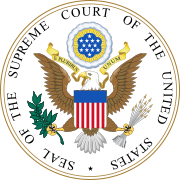|
List of United States Supreme Court cases, volume 17
This is a list of cases reported in volume 17 (4 Wheat.) of United States Reports, decided by the Supreme Court of the United States in 1819.[1] Nominative reportsIn 1874, the U.S. government created the United States Reports, and retroactively numbered older privately-published case reports as part of the new series. As a result, cases appearing in volumes 1–90 of U.S. Reports have dual citation forms; one for the volume number of U.S. Reports, and one for the volume number of the reports named for the relevant reporter of decisions (these are called "nominative reports"). Henry WheatonStarting with the 14th volume of U.S. Reports, the Reporter of Decisions of the Supreme Court of the United States was Henry Wheaton. Wheaton was Reporter of Decisions from 1816 to 1827, covering volumes 14 through 25 of United States Reports which correspond to volumes 1 through 12 of his Wheaton's Reports. As such, the dual form of citation to, for example, McCulloch v. Maryland is 17 U.S. (4 Wheat.) 316 (1819). Justices of the Supreme Court at the time of 17 U.S. (4 Wheat.)The Supreme Court is established by Article III, Section 1 of the Constitution of the United States, which says: "The judicial Power of the United States, shall be vested in one supreme Court . . .". The size of the Court is not specified; the Constitution leaves it to Congress to set the number of justices. Under the Judiciary Act of 1789 Congress originally fixed the number of justices at six (one chief justice and five associate justices).[2] Since 1789 Congress has varied the size of the Court from six to seven, nine, ten, and back to nine justices (always including one chief justice). When the cases in 17 U.S. (4 Wheat.) were decided, the Court comprised these seven justices:
Notable Cases in 17 U.S. (4 Wheat.) McCulloch v. MarylandMcCulloch v. Maryland, 17 U.S. (4 Wheat.) 316 (1819), is a landmark U.S. Supreme Court decision that defined the scope of the U.S. Congress's legislative power and how it relates to the powers of American state legislatures. The dispute in McCulloch involved the legality of the national bank and a tax that the state of Maryland imposed on it. In its ruling, the Supreme Court established that the "Necessary and Proper" Clause of the U.S. Constitution gives the U.S. federal government certain implied powers that are not explicitly enumerated in the Constitution, and that the American federal government is supreme over the states, and so states' ability to interfere with the federal government is limited. Sturges v. CrowninshieldSturges v. Crowninshield, 17 U.S. (4 Wheat.) 122 (1819), dealt with the constitutionality of New York having passed bankruptcy laws and retroactively applying them. Dartmouth College v. WoodwardDartmouth College v. Woodward, 17 U.S. (4 Wheat.) 518 (1819), is a landmark decision in United States corporate law from the United States Supreme Court dealing with the application of the Contracts Clause of the United States Constitution to private corporations. The case arose when the president of Dartmouth College was deposed by its trustees, leading to the New Hampshire legislature attempting to force the college to become a public institution, and so place the ability to appoint trustees in the hands of the governor of New Hampshire. The Supreme Court upheld the durability of the original charter of the college, which pre-dated the creation of the State. Citation styleUnder the Judiciary Act of 1789 the federal court structure at the time comprised District Courts, which had general trial jurisdiction; Circuit Courts, which had mixed trial and appellate (from the US District Courts) jurisdiction; and the United States Supreme Court, which had appellate jurisdiction over the federal District and Circuit courts—and for certain issues over state courts. The Supreme Court also had limited original jurisdiction (i.e., in which cases could be filed directly with the Supreme Court without first having been heard by a lower federal or state court). There were one or more federal District Courts and/or Circuit Courts in each state, territory, or other geographical region. Bluebook citation style is used for case names, citations, and jurisdictions.
List of cases in 17 U.S. (4 Wheat.)NOTE: Some decisions have alternate pagination, indicated by "{ }."
Notes and references
See alsoExternal links
Wikisource has original text related to this article:
|
|||||||||||||||||||||||||||||||||||||||||||||||||||||||||||||||||||||||||||||||||||||||||||||||||||||||||||||||||||||||||||||||||||||||||||||||||||||||||||||||||||||||||||||||||||||||||||||||||||||||||||||||||||||||||||||||||||||||||||||||||||||||||||||||||||||||||||||||||||||||||||||||||||||||||||||||||||||||||||||||||||||||||||











